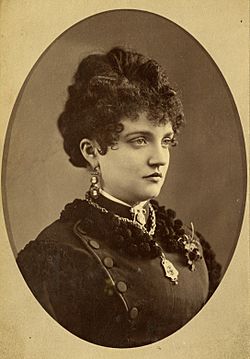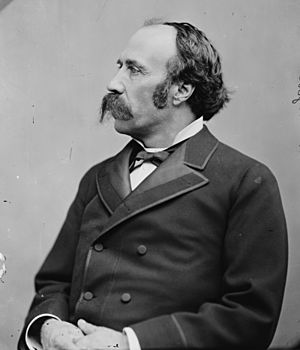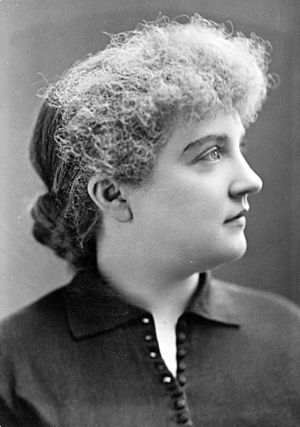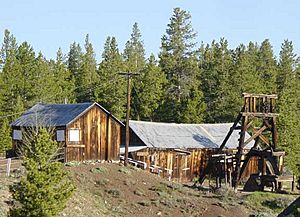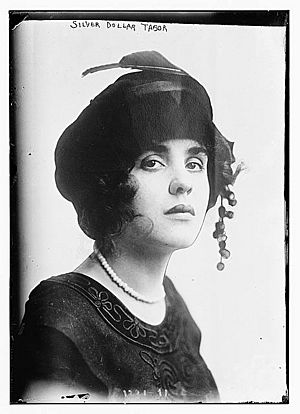Baby Doe Tabor facts for kids
Elizabeth McCourt Tabor (September 1854 – March 7, 1935), better known as Baby Doe, was the second wife of Colorado pioneer businessman Horace Tabor. Her rags-to-riches and back to rags again story made her a well-known figure in her own day, and inspired an opera and a Hollywood movie based on her life.
Born in Oshkosh, Wisconsin, she moved to Colorado in the mid-1870s with her first husband, Harvey Doe, whom she later divorced.
She then moved to Leadville, Colorado, where she met Horace Tabor, a wealthy silver magnate almost twice her age. In 1883, he divorced his first wife, Augusta Tabor, to whom he had been married for 25 years, and married Baby Doe in Washington, D.C., during his brief stint as a US senator, after which they took up residence in Denver. Although Tabor was one of the wealthiest men in Colorado, supporting his wife in a lavish style, he lost his fortune when the repeal of the Sherman Silver Purchase Act caused the Panic of 1893, with widespread bankruptcies in silver-producing regions such as Colorado. He died destitute, and she returned to Leadville with her two daughters, living out the rest of her life there.
At one time, the "best dressed woman in the West," for the final three decades of her life, she lived in a shack on the site of the Matchless Mine, enduring great poverty, solitude, and repentance. After a snowstorm in March 1935, she was found frozen in her cabin, aged about 81 years. Her story inspired the opera The Ballad of Baby Doe.
Contents
Early life and marriage
Elizabeth Bonduel McCourt was born in September 1854 in Oshkosh, Wisconsin, to Irish-Catholic immigrants Elizabeth Anderson Neilis and Peter McCourt. She later claimed to have been born in 1860 but appears on the 1860 Oshkosh census at 6 years of age. Born in September, according to the 1900 census, she appears to have been christened on October 7, 1854, at St. Peter's Catholic Church. Called Lizzie as a child, the fourth of eleven children, she grew up in a middle-class family in a two-story house. Her father was a partner in a local clothing store and owner of Oshkosh's first theater, McCourt Hall. Her mother fostered in her beautiful daughter the belief that her looks were of great worth, allowing her to dream of a future as an actress. Concerned by his wife's indulgence in their young and striking daughter, Peter McCourt thought it prudent to put her to work at the clothing store.
Oshkosh was a frontier lumber town, filled with mills. When fires raged through Oshkosh in 1874 and again in 1875, the McCourts lost their home, the clothing store, and the theater. They mortgaged their property to rebuild the home and the business, but this put Peter McCourt deeply in debt. The family was forced to live on what amounted to little more than a clerk's salary.
In 1876, Lizzie McCourt met Harvey Doe, who was a Protestant. She enchanted him when, as the only woman competitor, she entered and won a skating competition. Lizzy and Harvey were married in 1877 at the Catholic church, to the dissatisfaction of his parents. They then traveled with Harvey's father to Colorado to look after his mining investments, most importantly his half-ownership of the Fourth of July Mine in Central City. After a two-week honeymoon in Denver's American House, the newlyweds joined the elder Doe in the mining town in the mountains. Lizzie found Colorado enchanting. There she may have gained the nickname "Baby Doe".
Move to Colorado
In Central City, she quickly found that her husband's reserved temperament was unsuitable for a boisterous frontier mining town, and that he was unable either to manage a mine on his own or to follow his father's instructions on how to do so. Rather than see him fail, and enchanted with the possibility of becoming wealthy from mining gold, she helped her husband. She often dressed in mining clothes and worked directly in the mine. Despite a somewhat relaxed culture in the frontier mining town, those in the highest strata of the city's society considered her behavior and dress scandalous, causing her to be ignored. Through both their efforts, the Does did manage to bring up a small amount of gold, but when the vein ran out and a poorly constructed shaft collapsed, Harvey gave up and decided to take a job as a common mucker at another mine. He told his wife to stop wearing men's clothing and stay at home.

At that time, they moved from Central City to Black Hawk to live in a less expensive rooming house. Greatly disappointed and disenchanted by the noise and dirt in Black Hawk, Baby Doe began to take walks around the city each day. She lacked domestic skills with which to work and earn money, and she had nothing in common with the women of the town. Often, having little to do with her time, she visited the local clothing store, attracted in part by the expensive fabrics. She became friendly with the owner of the town's clothing store, Jake Sandelowsky. At the same time Harvey lost his job, and their marriage began to deteriorate.
Baby Doe followed Harvey to Denver, where she filed for divorce. Baby Doe then moved to Leadville, Colorado, almost certainly invited there by Sandelowsky, who changed his name to Sands. Alone and without a husband, Baby Doe needed to find a means of financial support quickly. Jake Sandelowsky, who opened a store in Leadville and almost certainly wanted to marry her, offered her employment. Working at a clothing store, however, was a prospect Baby Doe found dull, boring, and too similar to the life she had left behind in Oshkosh.
Leadville
In Leadville, she caught the attention of Horace Tabor, mining millionaire and owner of Leadville's Matchless Mine. Tabor was married, but in 1880 he left his wife Augusta Tabor to be with Baby Doe.
Baby Doe met Horace Tabor in a restaurant in Leadville one evening in 1880. She told him her story and that she had arrived in Leadville because of Jake Sandelowsky's generosity. Tabor gave her $5000 on the spot. Baby Doe then had a message, and $1000, delivered to Sandelowsky, in which she declared that she would not marry him. Sandelowsky later moved to Aspen, where he opened another store, married, and built a house.
Baby Doe claimed to love Tabor, and he loved her. He moved permanently out of his Denver home and asked his wife Augusta for a divorce. She refused him. Despite his existing marriage to Augusta, Horace Tabor and Elizabeth McCourt Doe married secretly in St. Louis, Missouri, in September 1882.
Marriage to Horace Tabor
In January 1883, Augusta sued Tabor again, and now he compensated her with real estate in Denver and stock in his mines. Tabor finally obtained a legal divorce at that time. That same month, the Colorado State Legislature appointed him to a 30-day term as United States Senator to fill a temporary vacancy, because the sitting senator, Henry Teller, had been appointed a cabinet member. Baby Doe and Horace married publicly on 1 March 1883, just two months after Tabor and Augusta had divorced. The marriage took place at the Willard Hotel in Washington, DC, during Tabor's brief tenure as a US senator. Baby Doe invited President Chester A. Arthur and other dignitaries, all of whom attended, as reported by the media at the time of her death, though a more recent biography claims many invitations were declined.
She planned a lavish wedding, going first to Oshkosh, making arrangements for her family to attend the event, and purchasing clothing and jewelry for them. Her mother was proud that her daughter was marrying a wealthy man, and Baby Doe herself was quite happy. Two days after the wedding, the priest who had performed the ceremony refused to sign the marriage license, when he learned that both the bride and the groom had previously divorced and that Baby Doe was a Roman Catholic. Although Tabor's contemporaries had winked at or ignored his dalliance with Baby Doe, Tabor's divorce and quick remarriage created a scandal, which prevented the couple from being accepted in polite society. Only a few months later, Horace's bid to be elected governor of Colorado ended in failure. Baby Doe's father died at around the same time.
The couple returned to Colorado, where they took up permanent residence in a Denver mansion. Baby Doe was snubbed by Denver socialites, from whom she received neither visits nor invitations. Although she did not join charities or clubs, as was customary during that period for wealthy women, she was generous with her money, donating funds to various charities and providing free offices to the Colorado suffragette movement. To keep herself busy, she shopped, bought jewelry and clothing, had her hair done and continued with the hobby of scrapbooking that she had taken up when living in Central City.
On July 13, 1884, she gave birth to the first of her and Tabor's two daughters, Elizabeth Bonduel Lily Tabor. The infant was christened in an extravagant and frilly outfit costing $15,000. Baby Doe was reportedly a good mother, staying at home with her daughter instead of accompanying Horace on his frequent trips to look after widespread business interests. Their second daughter, Rose Mary Echo Silver Dollar Tabor, was born on December 17, 1889. Both girls were attractive and well looked-after, and their mother doted on them. The second child was fondly called Silver or Silver Dollar, whom Baby Doe "defiantly nursed ... as she rode through the streets in Denver in one of her carriages."
A year after the birth of their second child, in 1890, the Sherman Silver Purchase Act was enacted, which brought to Colorado, and Colorado mine-owners, the hope that wildly fluctuating silver prices would stabilize. Profits from silver mining had diminished as the supply had declined and the extraction process and labor costs had increased. When a few of Horace's investments began to fail, he was forced to mortgage the Tabor theater in Denver and other real estate he had bought during the past decades.
Horace Tabor lost his fortune in 1893 when the repeal of the Silver Act caused the Panic of 1893. Silver prices plummeted and fortunes in Colorado were instantly wiped out. As she had with her first husband, Baby Doe pitched in. Horace gave her the legal power to run his business concerns in Denver, and she made decisions for him during his absences. To raise money, she sold most of her jewelry, and when the couple had the power turned off in their mansion, she made a game of it for the children. Eventually, the mansion and its contents were sold. At age 65, to earn a living, Horace took a job as a common mineworker, while the family lived in a boarding house. From 1893 to 1898, the Tabors endured great poverty, although some friends lent them money. To save him from poverty, some political friends arranged his appointment as postmaster of Denver in 1898. The family at that time lived on his annual salary of $3700 per year and took up residence in a plain room at the Windsor Hotel. Horace's health soon gave out, and 15 months after his appointment to the position, he died.
His funeral was well attended, with perhaps as many as 10,000 there. On his deathbed, he is said to have told Baby Doe to "hold on to the Matchless mine … it will make millions again when silver comes back." However, that story might not be true; by then, it appears they had mortgaged and/or lost the Matchless mine.
Later years
The Matchless mine
After her husband's death, Baby Doe stayed in Denver for a period, according to her diaries and correspondence. Why she decided to leave Denver and the society there to make a return to Leadville, in the high mountains with its cold winters, is unknown, but it almost certainly had to do with the Matchless mine. For two years, she unsuccessfully tried to find investors to bring the Matchless back into production. The family may have tried to regain ownership of the Matchless mine, but documentation is fragmented, and it is unclear to whom the mine belonged at that time. In 1901, one of her McCourt sisters may have attempted to buy the mine at a sheriff's sale, but again the fragmented documentation is murky about ownership. When Baby Doe moved with her girls back to Leadville, she claimed she would work the mine herself, despite its deteriorated condition. Temple writes that the mine's shafts were flooded and had not been in working condition for many years, and furthermore that Horace would have known this. To earn money, she took on menial domestic jobs. Unknown to her, her brother paid the grocer so that the three women had food. Eventually, in an attempt to keep the decrepit mine going and to raise funds, she reluctantly sold the "Isabella necklace" Tabor had given her, but during her lifetime she refused to sell his gold watch fob.
Her older daughter, Lily, left her mother to live with Baby Doe's family in Wisconsin. Later, after her mother died, Lily denied being Baby Doe's daughter. Of the two daughters, Lily, born into wealth, seemed more affected by the fall into poverty. When in 1902, Baby Doe traveled with her daughters to Oshkosh to visit her relatives, Lily decided then to prolong her visit, to stay and provide care for her elderly grandmother. Later, Lily moved to Chicago, where in 1908 she married her first cousin, and soon after gave birth to Baby Doe's grandchild. In 1911, Baby Doe and Silver again visited relatives in Wisconsin, going on to visit Lily in Chicago. After such a prolonged absence, Lily claimed she barely knew Silver Dollar.
After Lily's departure, Baby Doe and Silver Dollar moved into a cabin on the site of the Matchless mine. The living quarters were basic and inadequate for Colorado winters: "All told, it was no larger than a medium sized room. Two windows had been cut into the flimsy weatherboards, but these had been nailed up". The structure was a former tool shed located adjacent to the hoisthouse, described by a visitor in 1927 as "crowded with very primitive furniture, decorated with religious pictures, and stacked high in newspapers." The cabin was isolated, located above Leadville in Little Strayhorse Gulch, and had an unimpeded view of Mount Elbert and Mount Massive.
Baby Doe soon send Silver Dollar away to Denver. There, Silver Dollar wrote for the Denver Times, sending part of her earnings to her mother on a weekly basis. She then attempted to become a novelist. Perhaps to escape Colorado, she moved to Chicago, where again she tried her hand at writing. Eventually, after working as a dancer under various names, she met a Chicago gangster. In 1925, Silver Dollar was found dead under suspicious circumstances in her Chicago boarding house.
Alone in the cabin outside Leadville, Baby Doe turned to religion. She considered her life of great wealth a period of vanity and created penances for herself. During the bitterly frigid Colorado high-country winters, she wound burlap sacks around her legs. With no money, she ate very little, living on stale bread and suet, and refused to accept charity. Baby Doe lived like this for 35 years. During these years, she wrote incessantly. In diaries, letters, and scraps that she called "Dreams and Visions", consisting of about 2000 fragments later found bundled in piles of paper in her cabin.
She wandered the streets of Leadville, rags on her feet, wearing a cross, and came to be known as a madwoman. Some who had been acquainted with her earlier thought she deserved to suffer for having broken up the marriage between Horace and Augusta and believed that she had been the cause of his ruin. At that time, Leadville had lost much of its boomtown population and was becoming a ghost-town. She often walked the empty streets at night, dressed in a mixture of women's and men's clothing, wearing trousers and mining boots. She protected the mine from strangers with a shotgun and "she became a sad spectre of Baby Doe to old-timers; a spectacle to the young."
Death
In the winter of 1935, after an unusually severe snowstorm, some neighbors noticed that no smoke was coming out of the chimney at the Matchless mine cabin. Investigating, they found Baby Doe dead, her body frozen on the floor. For one last time, Baby Doe made the front pages of the papers. A funeral mass was held in Leadville, then her casket was sent by train to Denver. She was apparently 81 years old at the time of her death.
Her remaining possessions were auctioned off to souvenir collectors for $700. Baby Doe Tabor is buried with her husband in Mount Olivet Cemetery in Wheat Ridge, Colorado.
Reputation and legacy
Baby Doe Tabor is a legend among the women of the mining West. She holds the reputation of being a great beauty, a home-wrecker, and in her later years, a madwoman. Judy Nolte Temple writes that Baby Doe's legend, and her sins, grew quickly in retelling. She was rumored to be a gold-digger and a poor mother. Scavengers searched for non-existent treasure after her death, but Temple says the real treasure was found in Baby Doe's writing, which has taken decades to archive, analyze and study, and only now is beginning to reveal the inner life of the woman. Temple sees her as one in a long line of women who endured shunning and punishment for her beauty and for being disruptive to prevailing social norms. Temple speculates that Baby Doe's move to Leadville after Horace's death may have been self-shunning from Denver society.
Baby Doe was portrayed in the Warner Brothers film Silver Dollar, which premiered in Denver in 1932. "Lily", the fictionalized character of Baby Doe, was portrayed by actress Bebe Daniels; Edward G. Robinson played Yates Martin, a fictionalized Horace Tabor. Douglas Moore's opera The Ballad of Baby Doe premiered in Central City, Colorado, in 1956. In the New York premiere in 1958, Baby Doe was sung by Beverly Sills. In the 1970s, a string of western-themed "Baby Doe's Matchless Mine" restaurants was established in a number of US cities. Almost all are now closed.
In 1985, Baby Doe Tabor was inducted into the Colorado Women's Hall of Fame.
See also
- Silver Dollar (film)


